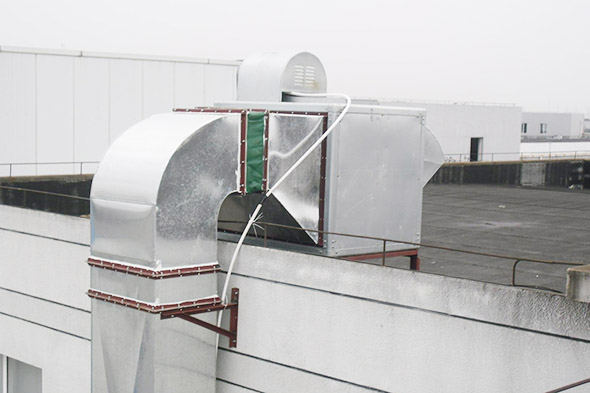
Tel:(86-769) 22664036
(86-769) 22677171
E-mail:chinadoto@dotofan.com Fax:(86-769) 23052218
(86-769) 23169348
Web site:www.dotofan.com
www.guotongfan.com
There are several categories of ventilation equipment
1, centrifugal fan
Centrifugal fan work, the power machine (mainly motor) drive the impeller in the scroll case rotation, the air through the suction port from the impeller center inhalation. As the blade of the gas on the dynamic role of gas pressure and speed can be improved, and under the action of centrifugal force along the leaf to the chassis, discharged from the exhaust. Because the gas flow in the impeller is mainly in the radial plane, it is also known as runoff fan.

Centrifugal fan is mainly composed of impeller and housing, small fan impeller mounted directly on the motor, the large fan through the coupling or pulley and motor connection. Centrifugal ventilators are generally single-sided intake, with a single stage impeller; large flow can be bilateral air intake, with two back to back impeller, also known as double suction centrifugal fan.
Impeller is the main part of the fan, its geometry, size, number of blades and manufacturing accuracy have a great impact on performance. The impeller is calibrated by static balance and dynamic balance to ensure smooth rotation of the fan. According to the different export direction of the leaves, the impeller is divided into three types: forward, radial and backward. The top of the blade of the forward impeller is inclined in the direction of rotation of the impeller; the top of the blade of the radial impeller is radial and sub-straight and curved blades; the reverse of the rotation of the blade at the top of the impeller to the impeller.
2, pipe fan
The impeller has the largest pressure, and the required impeller diameter is the smallest, but the efficiency is generally low. Radial impellers are between the two. The blade profile is straightforward with the simplest blades, the most complex of the wing blades.
In order to make the blade surface with a suitable velocity distribution, the general use of curved blades, such as equal thickness circular blade. The impeller usually has a cap to increase the strength of the impeller and to reduce the gas leakage between the blade and the enclosure. The connection of the blade to the cover plate is by welding or riveting. The welding impeller is lighter in weight and the flow path is smooth. Low, medium pressure small centrifugal fan impeller also used aluminum alloy casting.
3, axial fan
When the axial fan is operated, the power engine drives the impeller to rotate in the cylindrical housing. The gas enters from the current collector, obtains energy through the impeller, increases the pressure and speed, and then discharges in the axial direction. Axial fan layout in the form of vertical, horizontal and tilt three, small impeller diameter of only about 100 mm, large up to 20 meters or more.
4, axial fan
The small low-pressure axial fan is composed of impeller, housing and current collector. It is usually installed on the wall or ceiling of the building. The large high-pressure axial fan is composed of a current collector, impeller, streamer, And transmission parts. Leaves evenly arranged on the hub, the number is generally 2 to 24. The more leaves, the higher the wind pressure; blade installation angle is generally 10 ° ~ 45 °, the larger the installation angle, the greater the amount of wind and wind pressure. Most of the main parts of the axial fan are welded or riveted with steel plates.
5, oblique flow fan
In this type of ventilator, the gas enters the impeller in an angle with the axis, gains energy in the leaf and flows out in the oblique direction. The impeller and the shape of the fan are conical. This fan has both centrifugal and axial flow characteristics, flow range and efficiency are between the two.
6, cross flow fan
The cross flow fan is a small, high pressure centrifugal fan with a front multi-wing impeller. The gas enters the impeller from one side of the outer edge of the rotor and then passes through the inside of the impeller from the other side, and the gas is subjected to the force of the blade twice in the impeller. Under the same performance conditions, its size is small and the speed is low.
Compared with other types of low-speed fans, cross-flow fan with high efficiency. Its axial width can be arbitrarily selected without affecting the flow state of the gas, the gas remains in the entire rotor width evenly. Its outlet section is narrow and long, suitable for installation in a variety of flat-shaped equipment for cooling or ventilation.
The performance parameters of the ventilator are flow, pressure, power, efficiency and speed. In addition, the size of noise and vibration is also the main technical indicators of the fan. The flow rate is also referred to as the air pressure in the ventilator, and there is static pressure, dynamic pressure and total pressure. The power is Refers to the input power of the fan, ie shaft power. The ratio of the effective power of the ventilator to the shaft power is called efficiency. Ventilator full pressure efficiency of up to 90%.
The future development of the ventilator will further improve the aerodynamic efficiency of the ventilator, the efficiency of the device and the use efficiency, in order to reduce the power consumption; with the rotor adjustable axial fan instead of large centrifugal fan; reduce fan noise; Dust exhaust fan impeller and chassis wear resistance; to achieve variable speed adjustment and automatic adjustment.
 Marketing Center: 2nd Floor, South Project Home, Bayi Road, Dongguan City, Guangdong Province, China
Marketing Center: 2nd Floor, South Project Home, Bayi Road, Dongguan City, Guangdong Province, China
 Tel:Mr. Xie /+86 189-3815-9307/+86 189-3815-9307
Tel:Mr. Xie /+86 189-3815-9307/+86 189-3815-9307 E-mail:chinadoto@dotofan.com
E-mail:chinadoto@dotofan.com